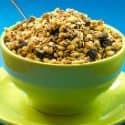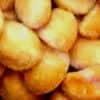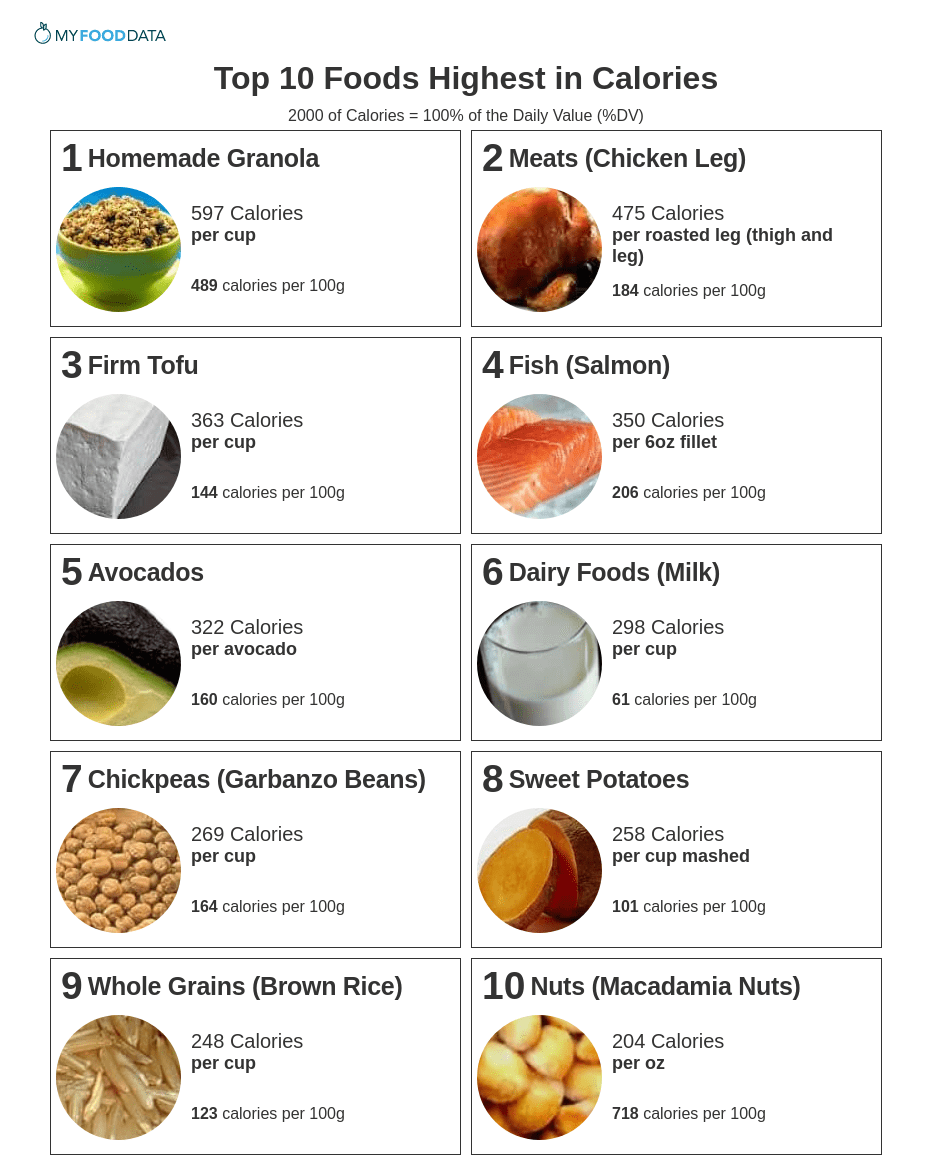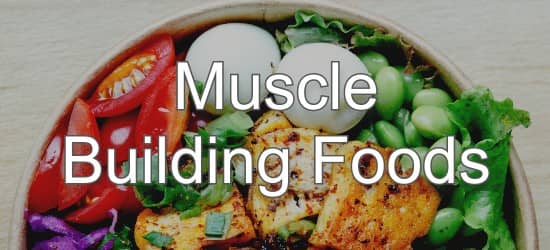Top 10 Foods Highest in Calories

Calories are the basic unit of energy used for measuring the energy in food and we all need a certain number of calories to maintain the body's vital functions. The number of calories a person needs depends on factors such as age, gender, and lean muscle mass.
Eating too few calories for a prolonged period of time causes a person to become underweight leading to muscle atrophy, weakened immunity, and eventually, organ failure. Conversely, eating too many calories causes a person to become overweight then obese, increasing their chances of heart disease, type II diabetes, and cancer.
People looking to gain weight in the form of lean muscle mass can aim to eat around 3000 calories per day depending on how many strength-building exercises they are doing.
Healthy high-calorie foods include granola, meats, tofu, fish, avocados, milk, beans, sweet potatoes, whole grains, and nuts. In general, the daily value (DV) for calories is 2000 calories per day, but people active with strength training or other exercises may want to consume more.
Below is a list of the top 10 high calorie foods ranked by common serving size, if you are looking to lose weight, see the list on unhealthy high calorie foods to avoid. If you are looking to gain weight, see the section on select meal portions for eating more calories, and the article on high calorie weight gain meal plans.
-
 1. Homemade Granola
1. Homemade Granola
Calories per Cup Calories per 100g 597 calories 489 calories Note: Be sure to check that the amount of sugar is not too high in your granola. To make it a healthy high-calorie breakfast add nuts and seeds, a few dried fruits, and consume it with milk or milk substitutes.
See all cereals high in calories.
-
 2. Meats (Chicken Leg)
2. Meats (Chicken Leg)
Calories per Roasted Leg (Thigh And Leg) Calories per 100g 475 calories 184 calories More Meats High in Calories
Try to choose lean cuts.- 369 calories in 1 cup of roast ham
- 360 calories in a 6oz of beef pot roast
- 332 calories in a 6oz lean pork chop
- 268 calories in a 5oz chuck steak
- 231 calories in a 1 cup of diced chicken breast
See the full list of high calorie meats.
-
 3. Firm Tofu
3. Firm Tofu
Calories per Cup Calories per 100g 363 calories 144 calories More Soy Products High in Calories
- 376 calories in 1 cup of green soybeans
- 369 calories in 1 cup of tempeh
- 160 calories in a 16 oz glass of soymilk
-
 4. Fish (Salmon)
4. Fish (Salmon)
Calories per 6oz Fillet Calories per 100g 350 calories 206 calories More Fish High in Calories
- 445 calories in 6oz of Atlantic Mackerel
- 313 calories in 6oz of tuna
- 310 calories in 1 cup of canned sardines
See the full list of fish high in calories.
-
5. Avocados
Calories per Avocado Calories per 100g 322 calories 160 calories Other fruits high in calories include plantains, bananas, and guavas. Dried fruit and fruit juices are also very high in calories, but be careful about the sugar content!
See the complete list of over 100 fruits high in calories.
-
 6. Dairy Foods (Milk)
6. Dairy Foods (Milk)
Calories per Cup Calories per 100g 298 calories 61 calories More Dairy Foods High in Calories
- 216 calories in 1/2 cup of ricotta cheese
- 149 calories in 1 cup of plain yogurt
- 119 calories in 1 ounce of grated parmesan
See all dairy foods high in calories.
-
 7. Chickpeas (Garbanzo Beans)
7. Chickpeas (Garbanzo Beans)
Calories per Cup Calories per 100g 269 calories 164 calories More Beans High in Calories
- 255 calories in 1 cup of navy beans
- 254 calories in 1 cup of white beans
- 245 calories in 1 cup of pinto beans
See all beans and lentils high in protein.
-
 8. Sweet Potatoes
8. Sweet Potatoes
Calories per Cup Mashed Calories per 100g 258 calories 101 calories More Vegetables High in Calories
- 161 calories in a medium baked potato
- 134 calories in a cup of green peas
See the full ranking of high calorie vegetables.
-
 9. Whole Grains (Brown Rice)
9. Whole Grains (Brown Rice)
Calories per Cup Calories per 100g 248 calories 123 calories More Whole Grains High in Calories
- 222 calories in 1 cup of quinoa
- 174 calories in 1 cup of whole wheat pasta
- 166 calories in 1 cup of oatmeal
See all high calorie grains.
-
 10. Nuts (Macadamia Nuts)
10. Nuts (Macadamia Nuts)
Calories per Oz Calories per 100g 204 calories 718 calories More Nuts High in Calories
- 196 calories per oz of pecans
- 191 calories per oz of pine nuts
- 187 calories per oz of dried coconut
- 170 calories per oz of almonds
- 167 calories per oz of peanuts
See the list of nuts high in calories.
Printable One Page Sheet

Tips for Gaining Weight
- Add high calorie foods to existing dishes - Nuts, seeds, and dried fruit make a great addition to salads, rice dishes, pasta dishes, etc.
- Add healthy fats and oils to existing dishes - Add olive oil, peanut oil, or safflower oil to as many foods as possible. For example, rice, other gains, pasta, salads etc.
- Increase portion sizes - Create larger meals of calorie dense foods like rice, mashed potatoes, and pasta.
- Drink Calories - Drinks are an easy way to intake calories on the go. Drink juice, soy milk, milk, smoothies, and other healthy high-calorie beverages.
- Do Muscle Building (Anaerobic) Exercises - Muscle building exercises can increase appetite and also increase weight as your body builds muscle. This is especially true when combined with high protein foods like nuts, peanut butter, fish, or beans.
- Track your progress and set goals - Setting goals and targets is important to any achievement. Set healthy weight gain targets each month. No more than 7lbs (~3.5kg) a month is reasonable.
Select Meal Portions for Eating More Calories
- 1/2 Cup of Macadamia Nuts: 474 calories
- 1/2 Cup of Almonds: 411 calories
- 1 Glass of Grape Juice (16oz): 308 calories
- 2 Whole Wheat Crackers with a 1 ounce slice of Cheese on each: 262 calories
- 2 Whole Wheat Crackers with 1 tbsp of Peanut Butter on each: 224 calories
- 1 Cup Brown Rice (Cooked): 218 calories
- 1 Cup Brown Rice (Cooked) with 2 tbsp of Olive Oil: 466 calories
- 1 Cup Oatmeal (Cooked): 166 calories
- 1 Cup Oatmeal with 1/4 Cup Raisins and 1/4 Cup Almonds: 480 calories
- 1 Square of Dark Chocolate (29g): 145 calories
- 1/2 Cup of Dates: 208 calories
- 1/2 Cup of Dried Apricots: 156 calories
About the Data
Data for the curated food lists comes from the USDA Food Data Central Repository.
You can check our data against the USDA by clicking the (Source) link at the bottom of each food listing.
Note: When checking data please be sure the serving sizes are the same. In the rare case you find any difference, please contact us and we will fix it right away.
About Nutrient Targets
Setting targets can provide a guide to healthy eating.
Some of the most popular targets include:- Daily Value (%DV) - The daily value (%DV) is a general guideline for consumption that will prevent deficiency of a particular nutrient in most people. The %DV refers to the percentage of an amount that\'s found in a single serving of a food. It also accounts for absorption factors. It is set by the U.S. FDA.
- Recommended Dietary Allowance (%RDA) - The RDA sets an average daily dietary intake level that is sufficient to meet the nutrient requirements of nearly all (97.5%) healthy individuals. It\'s more specific than the daily value, and varies by age and gender. The RDA is set by the US National Institutes of Health.
- Reference Dietary Intake (%RDI) -The reference dietary intake is similar to the recommended daily allowance, but is specific to age and gender. The RDI for amino acids is set by the U.N. World Health Organization.
- Adequate Intake (%AI) - This value is primarily used in reference to omega-3 and omega-6 fats. The Adequate Intake is set by the U.S. Institute of Medicine. Because there is less evidence to determine the ideal targets for consumption of these nutrients, the specific amount is considered to be less reliable. Using the term Adequate Intake, rather than one of the other terms, helps to emphasize that the ideal intake of that particular nutrient has not yet been scientifically determined.
See the Guide to Recommended Daily Intakes for more information.
Want to set your own targets? Sign up for an account and set custom targets in the daily food log.From the Nutrient Ranking Tool
Use the ranking tool links below to select foods and create your own food list to share or print.
- Foods High in Calories
- Foods Low in Calories
- Vegetables High in Calories
- Fruits High in Calories
- Vegetarian Foods High in Calories
- Nuts High in Calories
- Grains High in Calories
- Beans High in Calories
- Dairy High in Calories
- Breakfast Cereals High in Calories
- Fast Foods High in Calories
View more nutrients with the nutrient ranking tool, or see ratios with the nutrient ratio tool.
Related
Data Sources and References
Try the recipe nutrition calculator, or daily meal planner.
Create a free account to log and track foods.

 Next ➞
Next ➞